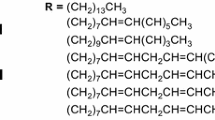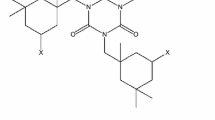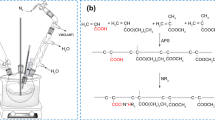Abstract
Fluorinated acrylate quadripolymer (QPFA), acrylate bipolymer (BPFA), and acrylate homopolymer (HPFA) were synthesized by free radical polymerization using different monomers. The three fluoropolymers (5%) were mixed respectively with acrylic varnish, and HPFA at different concentrations (1, 3, 5, 7, and 10 wt%) was mixed with acrylic varnish. The polymer films were characterized by differential scanning calorimetry, X-ray diffraction, water absorption rates, and contact angle analyses; the coatings were characterized by confocal laser scanning microscopy, mechanical analyses, water contact angles, water absorption rates, and biofouling analyses. Results indicate that the three coatings containing different fluoropolymers have comparable mechanical properties. The QPFA coating featured the lowest resistance to benthic diatom adhesion because of its low fluorine content. With increasing fluorine contents, the mechanical properties of the HPFA coatings decreased. However, the contact angles and resistance to adhesion increased. Though the HPFA particles lowered adhesion between the matrix and coating, they simultaneously generated rough surfaces.












Similar content being viewed by others
References
Yebra, DM, Kiil, S, Kim, DH, “Antifouling Technology-Past, Present and Future Steps Towards Efficient and Environmentally Friendly Antifouling Coatings.” Prog. Org. Coat., 50 (2) 75–104 (2004)
Robert, F, “Clean Hulls Without Poisons: Devising and Testing Nontoxic Marine Coatings.” J. Coat. Technol., 72 (900) 45–56 (2000)
Champ, MA, “A Review of Organotin Regulatory Strategies, Pending Actions, Related Costs and Benefits.” Sci. Total Environ., 258 21–71 (2000)
Rascio, VJD, “Antifouling Coatings: Where Do We Go From Here.” Corros. Rev., 18 (2) 133–154 (2000)
Meyer, AE, Baier, RE, King, RW, “Initial Fouling of Nontoxic Coatings in Fresh, Brackish, and Sea Water.” Can. J. Chem. Eng., 66 55–62 (1988)
Evans, SM, Birchenough, AC, Brancato, MS, “The TBT Ban: Out of the Frying Pan into the Fire?” Mar. Pollut. Bull., 40 204–211 (2000)
Tsibouklis, J, “Fluoropolymer Coatings with Inherent Resistance to Biofouling.” Surf. Coat. Int. B, 84 (4) 301–308 (2002)
Brady, R, Aronson, C, “Elastomeric Fluorinated Polyurethane Coatings for Nontoxic Fouling Control.” Biofouling, 19 (1) 59–62 (2003)
Zhang, YM, Li, H, Fluorinated Functional Materials. Chemical Industry Press, Beijing, 2008
Chen, ZH, Zhao, XJ, “Progress of Fluorinated Acrylate Copolymer Emulsion.” Paint Coat. Ind., 37 (9) 57–60 (2007)
Park, IJ, Li, SB, Chang, KC, Kim, KJ, “Surface Properties and Structure of Ploy(perfluoroalkylethyl methacrylate).” J. Colloid Interface Sci., 181 (1) 284–288 (1996)
Tian, J, Zhou, ZF, Xu, JF, “Nontoxic Antifouling Marine Coating.” China Patent CN:1097447A, 1995
Brady, RF, Bonafede, SJ, Schmidt, DL, “Self-assembled Water-Borne Fluoropolymer Coatings for Marine Fouling Resistance.” Surf. Coat. Int., 82 (12) 582–585 (1999)
Tian, J, Xue, Q, “The Study on Surface Structure of Nontoxic Antifouling Coatings.” Chin. J. Environ. Sci., 19 (1) 46–49 (1998)
Bongiovanni, R, Malucelli, G, Lombardi, V, “Surface Properties of Methacrylic Copolymers Containing a Perfluoropolyether Structure.” Polymer, 42 (6) 2299–2305 (2001)
Schmidt, DL, Brady, RF, et al., “Contact Angle Hysteresis, Adhesion, and Marine Biofouling.” Langmuir, 20 (7) 2830–2836 (2004)
Ameduri, B, Bongiovanni, R, “Effect of the Structural Parameters of a Series of Fluoromonoacrylates on the Surface Properties of Cured Films.” J. Polym. Sci. A, 39 (24) 4227–4235 (2001)
Krishnan, S, Wang, N, Ober, CK, “Comparison of the Fouling Release Properties of Hydrophobic Fluorinated and Hydrophilic PEGylated Block Copolymer Surfaces: Attachment Strength of the Diatom Navicula and the Green Alga Ulva.” Biomacromolecules, 7 (5) 1449–1462 (2006)
Gudipai, CS, Finalay, JA, “The Antifouling and Fouling-Release Perfomance of Hyperbranched Fluoropolymer (HBFP)-Poly(ethylene glycol) (PEG) Composite Coatings Evaluated by Adsorption of Biomacromolecules and the Green Fouling Alga Ulva.” Langmuir, 21 (7) 3044–3053 (2005)
Elisa, M, Serena, A, “Nanostructured Films of Amphiphilic Fluorinated Block Copolymers for Fouling Release Application.” Langmuir, 24 (22) 13138–13147 (2008)
Wenzel, RN, “Resistance of Solid Surfaces to Wetting by Water.” Ind. Eng. Chem., 28 (8) 988–994 (1936)
Öner, D, McCarthy, TJ, “Ultrahydrophobic Surfaces: Effects of Topography Length Scales on Wettability.” Langmuir, 16 7777–7782 (2000)
Yoshimitsu, Z, Nakajima, A, Watanabe, T, Hashimoto, K, “Effects of Surface Structure on the Hydrophobicity and Sliding Behavior of Water Droplets.” Langmuir, 18 5818–5822 (2002)
Quere, D, “Wetting and Roughness.” Annu. Rev. Mater. Res., 38 71–99 (2008)
Acknowledgments
This research is supported by The National Science Foundation of China (51079011, 51179018), the application basic research fund of the Ministry of Transport (2013329225330), The Fundamental Research Funds for the Central Universities, and the outstanding scientific innovation team plan of Dalian Maritime University (3132013313). The authors gratefully acknowledge this financial support.
Author information
Authors and Affiliations
Corresponding author
Rights and permissions
About this article
Cite this article
Zhang, Y., Qi, Yh., Zhang, Zp. et al. Synthesis of fluorinated acrylate polymer and preparation and properties of antifouling coating. J Coat Technol Res 12, 215–223 (2015). https://doi.org/10.1007/s11998-014-9623-6
Published:
Issue Date:
DOI: https://doi.org/10.1007/s11998-014-9623-6




